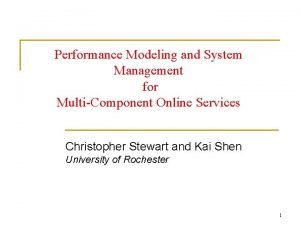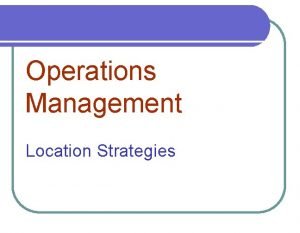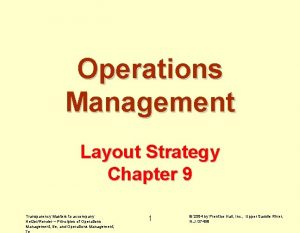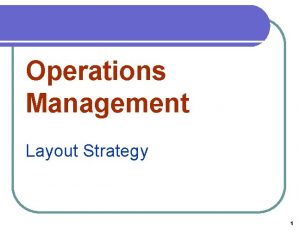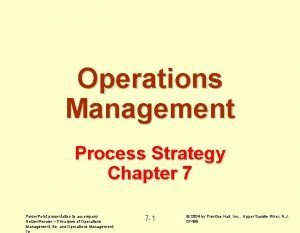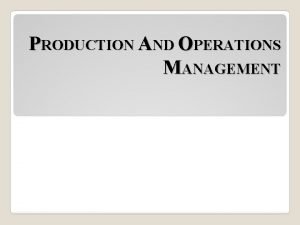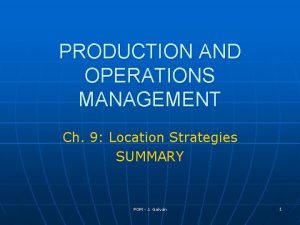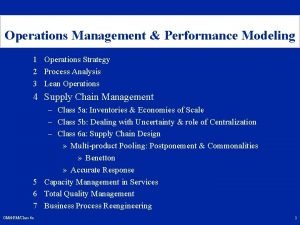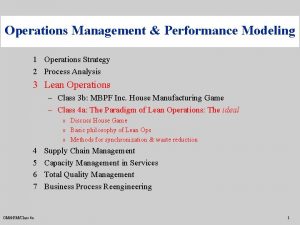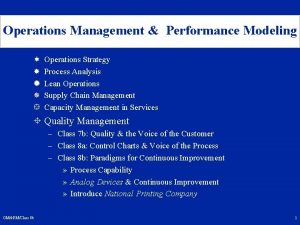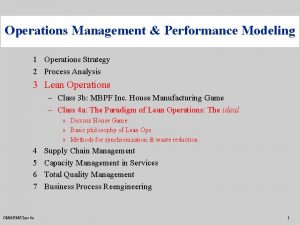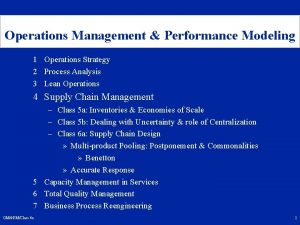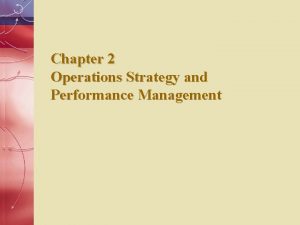Operations Management Performance Modeling 1 Operations Strategy 2













- Slides: 13

Operations Management & Performance Modeling 1 Operations Strategy 2 Process Analysis 3 Lean Operations 4 Supply Chain Management – Class 5 a: Inventories & Economies of Scale – Class 5 b: Dealing with Uncertainty & role of Centralization » The impact of uncertainty: safety stocks » Centralization: pooling benefits 5 Capacity Management in Services 6 Total Quality Management 7 Business Process Reengineering OM&PM/Class 5 b 1

South Face: warehouses Service levels & inventory management u u The South Face has 4 warehouses which experience a demand that is not steady from one week to the next. Weekly demand is in fact normally distributed with a mean of 5, 000 and a standard deviation of 1, 500. SF’s order lead time is two weeks. Fixed order costs are $2, 000/order and it costs $50 to hold one jacket in inventory during one year. – If SF uses the ordering policy discussed last class, what will the probability of running out of stock in a given cycle be? SF would like this probability to be no higher than 5% for customer satisfaction. What ordering policy would you recommend for SF? OM&PM/Class 5 b 2

Safety Stocks Inventory on hand I(t) Q Q order ROP R mean demand during supply lead time: ss m=RL safety stock 0 ss Time t L OM&PM/Class 5 b L 3

Hedge against demand uncertainty with safety stocks u u u L D=N(R, s. R) = Supply lead time, =Demand per unit time is normally distributed with mean R and standard deviation s. R , Cycle service level = P(no stock out) = P(demand during lead time < ROP) = P(N(0, 1) < z* = (ROP- m)/s. LTD) = F(z*) [use tables to find z*] Safety stock ss = z* s. LTD Reorder point ROP = RL + ss OM&PM/Class 5 b 4

The standard normal distribution F(z) • Transform X = N(m, s) to z = N(0, 1) z = (X - m) / s. F(z) = Prob( N(0, 1) < z) F(z) 0 z • Transform back, knowing z*: X* = m + z*s. OM&PM/Class 5 b 5

Determining the required Safety Stock: at each warehouse of the South Face DATA: R = 5, 000 jackets/ week H = $ 50 / jacket, year S = $ 2, 000 / order s. R = 1, 500 jackets/ week L = 2 weeks QUESTION: What should safety stock be to insure a desired cycle service level of 95%? ANSWER: 1. Determine s lead time demand = 2. Required # of standard deviations z* = 3. Answer: Safety stock = OM&PM/Class 5 b 6

Comprehensive Financial Evaluation: Warehouse Inventory Costs of the South Face 1. Cycle Stock (Economies of Scale) 1. 1 Optimal order quantity 1. 2 # of orders/year = = 1. 3 Annual ordering cost per warehouse = $114, 017. 1. 4 Annual cycle stock holding cost/w. h. = $114, 017. 2. Safety Stock (Uncertainty hedge) 2. 1 Safety stock per warehouse = 3, 500 2. 2 Annual safety stock holding cost/w. h. = $174, 982. 3. Total Costs for 4 warehouses OM&PM/Class 5 b = 4 (114, 017 + 174, 982) = $1, 612, 069. 7

Learning Objectives: safety stocks Safety stock increases (decreases) with an increase (decrease) in: u demand variability or forecast error, u delivery lead time for the same level of service, u delivery lead time variability for the same level of service. OM&PM/Class 5 b 8

The Effect of Centralization u Weekly demand per warehouse = 5, 000 jackets/ week with standard deviation = 1, 500 / week H = $ 50 / jacket, year S = $ 20, 000 / order Supply lead time L = 2 weeks Desired cycle service level F(z*) = 95%. u The South Face decides to merge all of its warehouses. m= s= OM&PM/Class 5 b 9

The Effect of Pooling pairs of warehouses R = 10, 000 widgets/week s = Sqrt(2) 4, 000 = 5, 657 widgets/week Optimal order quantity Q per 2 -warehouse = 20, 396 widgets/order. Annual ordering cost per 2 -warehouse = $50, 990. s lead time demand Safety stock per 2 -warehouse Reorder point Average inventory 2 -warehouse Average cycle time Annual holding cost per 2 -warehouse = 6, 928 widgets. Total average inventory across two 2 -warehouses Total annual cost across two 2 -warehouses = 43, 260 widgets. = $318, 280. OM&PM/Class 5 b = 11, 432 widgets. = 26, 432 widgets. = 21, 630 widgets. = 2. 16 weeks. = $108, 150. 10

Comprehensive Financial Evaluation of centralizing Four Warehouses into One R = 20, 000 jackets/week s. R = Sqrt(4) 1, 500 = 3, 000 jackets/week 1. Cycle Stock Optimal order quantity Q consolidated warehouse Annual ordering cost = 9, 121 jackets/order. = $228, 035. 2. Safety Stock s lead time demand = 4, 242 jackets. Safety stock consolidated warehouse = 7, 000 jackets. Reorder point = 47, 000 jackets. Average inventory consolidated warehouse = 11, 560 jackets. Average flow time Annual holding cost Total annual cost consolidated warehouse = 0. 578 weeks. = $578, 000. = $806, 034. OM&PM/Class 5 b 11

Supply Chain of IBM PC Europe u Build to Plan (BTP) vs. Late Customization (LC) vs. Build to Order (BTO) vs. Exploiting component commonality(FLEX) u Physical Pooling of transhipment points Source: Feigin, An, Connors and Crawford, ORMS Today April 96 OM&PM/Class 5 b 12

Learning Objectives: centralization/pooling èDifferent methods to achieve pooling efficiencies: – – Physical centralization Information centralization Specialization Raw material commonality (postponement/late customization) èCost savings are sqrt(# of locations pooled). OM&PM/Class 5 b 13
 Modeling role modeling theory
Modeling role modeling theory Dimensional modeling vs relational modeling
Dimensional modeling vs relational modeling Performance levels
Performance levels Performance levels
Performance levels Performance modeling
Performance modeling What are the four types of process strategies
What are the four types of process strategies Locational break even analysis operations management
Locational break even analysis operations management Retail layout operations management
Retail layout operations management Layout strategies
Layout strategies Process strategy operations management
Process strategy operations management Process strategy in operations management
Process strategy in operations management Location strategy in operations management
Location strategy in operations management Location strategy in operations management
Location strategy in operations management Service process matrix
Service process matrix




